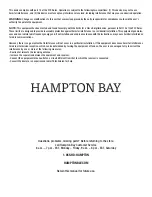
16
Check the support connections, brackets, and blade attachments twice a year. Make sure they are secure. Because of the fan’s
natural movement, some connections may become loose over time. It is not necessary to remove the fan from the ceiling.
Clean your fan periodically. Use only a soft brush or lint-free cloth to avoid scratching the finish. The plating is sealed with a lacquer to
minimize discoloration or tarnishing.
(Optional) Apply a light coat of furniture polish to the wood blades.
(Optional) Cover small scratches with a light application of shoe polish.
Do
Care and Cleaning
Use water when cleaning. Water could damage the motor, or the wood, or possibly cause an electrical shock.
Apply oil to your fan or motor. The motor has permanently-lubricated sealed ball bearings.
Do not
Troubleshooting
Problem
Solution
The fan will not start.
Check the main and branch circuit fuses or breakers.
Check the line wire connections to the fan and switch wire connections in the switch housing.
Check to make sure the frequency switches from the remote control and receiver are set to the same
frequency.
Turn the AC power off, and turn the AC power on after 10 seconds.
Reset the transmitter by going through the transmitter “LEARNING PROCESS”.
The fan sounds noisy.
Make sure all motor housing screws are snug.
Make sure the screws that attach the fan blade to the motor hub are tight.
Make sure the wire nut connections are not rattling against each other or the interior wall of the switch
housing.
Allow a 24-hour "breaking-in" period. Most noises associated with a new fan disappear during this time.
If using the ceiling light kit, make sure the glassware is secured tightly.
Make sure there is a short distance from the ceiling to the canopy. It should not touch the ceiling.
Make sure your ceiling box is secure and that rubber isolator pads are used between the mounting
bracket and outlet box.
The remote control is
not working.
Do not connect the fan with wall mounted variable speed control(s).
Make sure the frequency switches are set correctly.
Reset the transmitter by going through the transmitter “LEARNING PROCESS”.
The fan wobbles.
Fan moves backwards and
forwards when turned on.
This is normal start-up procedure for DC motor fans. The partial movement during start-up is the result
of the DC motor aligning the internal magnetic poles for proper motor operation. This design saves
electricity and allows the fan to operate much quieter than standard AC motor fans.
Verify that all blades and blade bracket screws are secure (most fan wobble problems are caused by
loose parts). Once the fan is properly installed, run the ceiling fan for 10 minutes to let the fan
self-adjust.
If wobble occurs after running the fan for 10 minutes, verify blade level using the following process:
Select a point on the ceiling above the tip of one of the blades, then select any fan blade and measure
from the center of the selected blade to the point on the ceiling. Rotate the fan until the next blade is
positioned and repeat the measurement using the same point from the ceiling for every blade.
Measurement deviations should be within 1/8 in..
If all deviations are less than 1/8 in. and the fan continues to wobble, please call Customer Service
(1-855-HD-HAMPTON) to order a complimentary blade balancing kit.
If deviation is greater than 1/8 in., please call Customer Service (1-855-HD-HAMPTON) to order
complimentary replacements of your brackets.

































